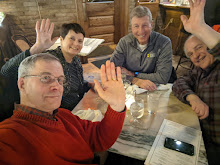
For people who don't know New England milltowns of the 1900s, they have -- or had -- three faces. The bottom rung was the first- or second-generation immigrant who worked the mills, the middle rung was the small business owners and factory bosses, and also the farmers, and the top rung was the mill owner and city entrepreneur.
It's easy, I think, to look at New England's cities and see only one face these days, but that would be wrong. I happen to like the industrial age, so I'm still taken with the architecture and history of the mills. This one used to be a toy manufacturer.

This was a cardboard box plant...

If you had a key on a chain, it probably came through Fitchburg. One of my college summer jobs was working at Independent Lock (Ilco), helping them move stuff out of the plant, on its way to its new home in North Carolina. When John Edwards was running for president and bemoaned the loss of jobs in North Carolina to Mexico, I didn't care much. Whatever Mexico did to North Carolina, North Carolina did to Massachusetts first.
But if you turn your focus from the industrial city, you can drive for 3 minutes out of town, and be in the "country" part of the city, and be reminded about New England's common rural beauty, marred though it presently is from last December's massive ice storm.

Dairy farming was big here, much of it by Finnish immigrants, much of it by a few centuries of colonists. But all of it was on land in which you still can't stick a shovel in the ground without hitting a rock, a fact which led to thousands of miles of stone walls.

The fields are woods now, which makes Fitchburg a great place for people with money looking for their homes on a hill in the woods. You can have a backyard with a view of Mt. Wachusett, the second-largest mountain in Massachusetts. From the top, you can see Boston, just 50 miles away.

If I were in a plane now, and we got up another couple of thousand feet, you'd see the ocean thataway...

On my drive around, I also took note of this:

This is known as "the rock" on Rollstone Hill. For generations, it was tradition for the senior class at Fitchburg High School (that long brick building with the white spire at the center top of the picture at the top of the page was my high school; it's closed now) to paint it with FHS and then the class year underneath -- in my case 1972.
It was a source of great pride and it was a pain in the neck to paint it because that rockface is a sheer drop and it's slick from decades of paint. There were holes for stakes at the bottom along which we'd tie a rope. On the lone time I went up to help paint in my senior year, that rope saved one classmate. He started skidding down the face and grabbed the rope shortly before he would've fallen off.
As loyal Red Raiders, we would defend "the rock" at all costs against the heathens from Leominster High School, who -- around the time of the annual Thanksgiving football game between the two schools -- would try to deface it with gallons of blue paint.
Now, however, it is just another giant hunk of graffiti. When did that change? I'll tell you when. 1972. In that year, not only did we have to defend it against Leominster High School, but also against the Fitchburg High School Class of 1973, who often painted over the "72" and made it a "73." The pricks.
So today, I notice there were a couple of kids up on "the rock."

I'll bet they have no idea of the history upon which they stood.

1 comment:
Hi
Feelings of nostalgia came flooding in as I read your articles. I graduated in 1959 from FHS. I remember the fun football games and watching FHS and Leominster play on Thanksgiving. Remember "dragging" down main street checking out the fellows some with slicked da's.
My grandpa worked at Crocker Burbank Paper Mill-- a great company. Remember Crocker field?
Crockers had a feeling of family and was run by family. I worked there too. My grandpa lost a few fingers in the mill. Grandma and Grandpa made hooked rugs out of the old felts. They dyed and made strips out of the felts. They bought a house Crockers had built for their employees.
Yes, the river was nasty.
It is sad to return to Fitchburg. I left in 64 for California and came back to marry in 66. I was so shocked to see Fitchburg. It looked so old and dying.
I live in North Carolina now. A vibrant growing city. Three hours to the beach and 4 hours to the mountains. Yes, they are loosing companies and jobs also to overseas.
Thank you for your article.
Post a Comment